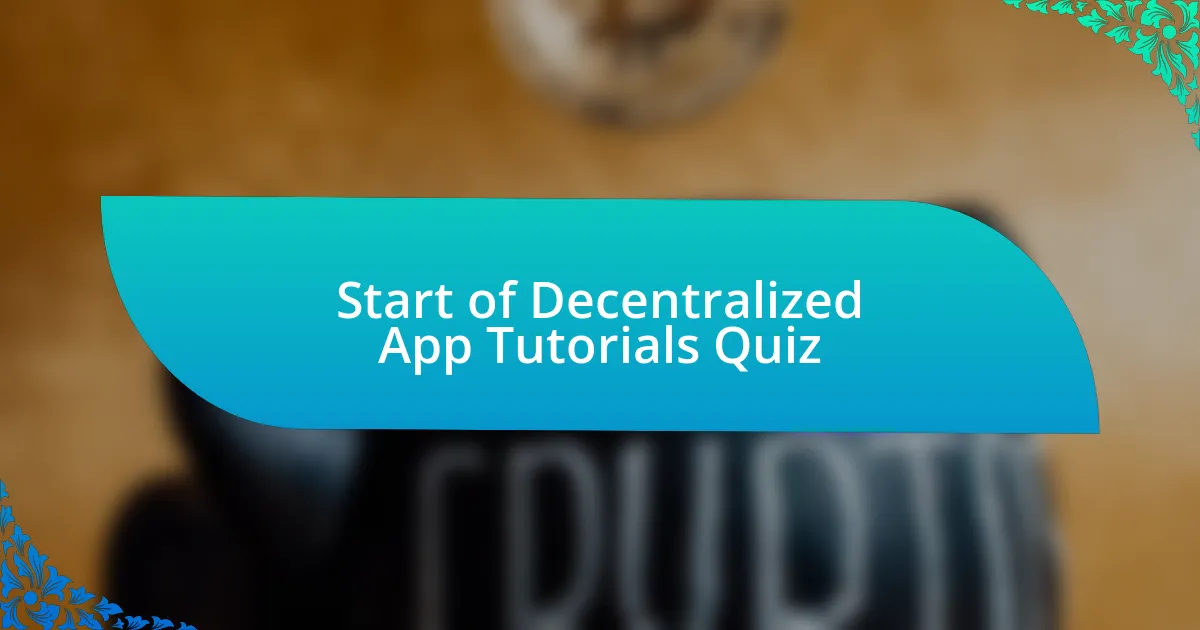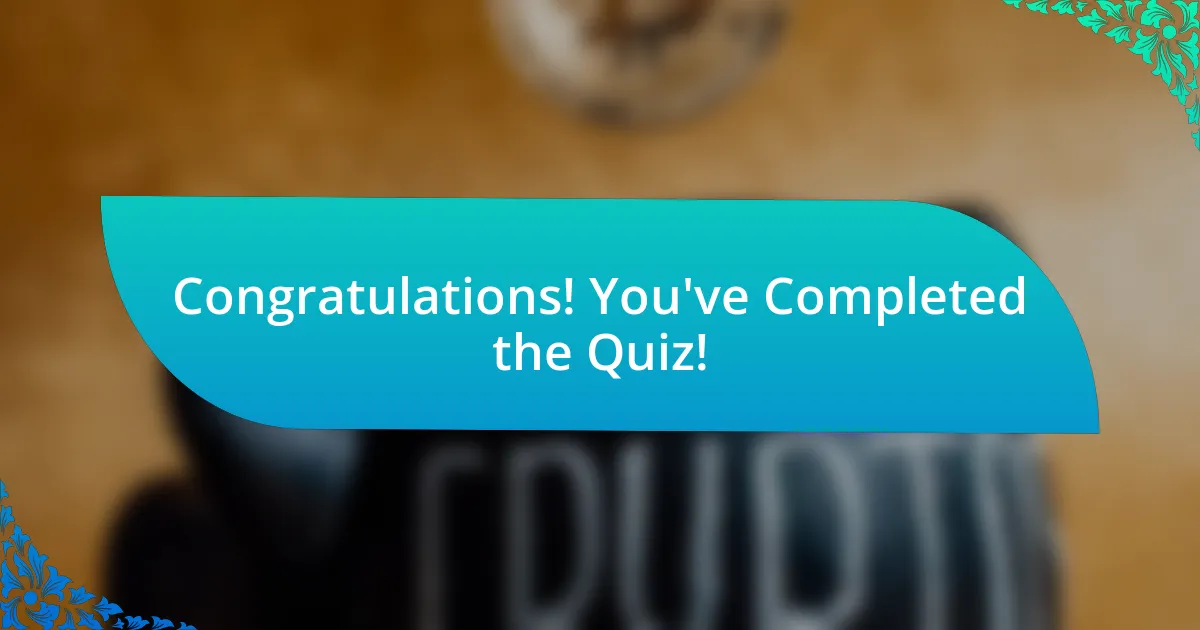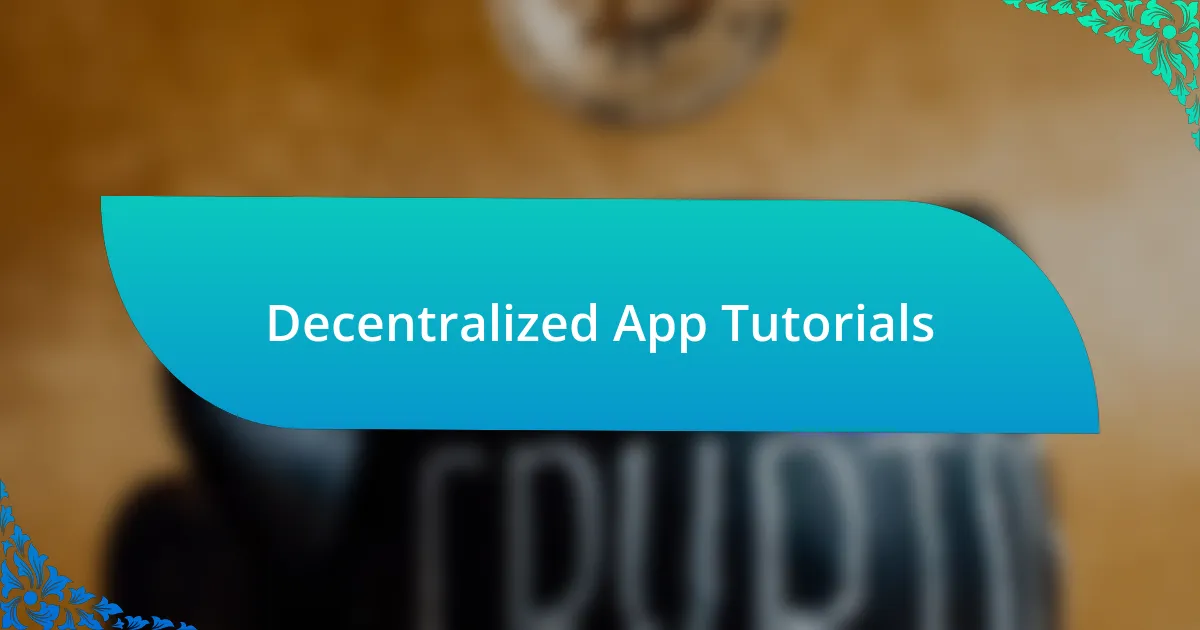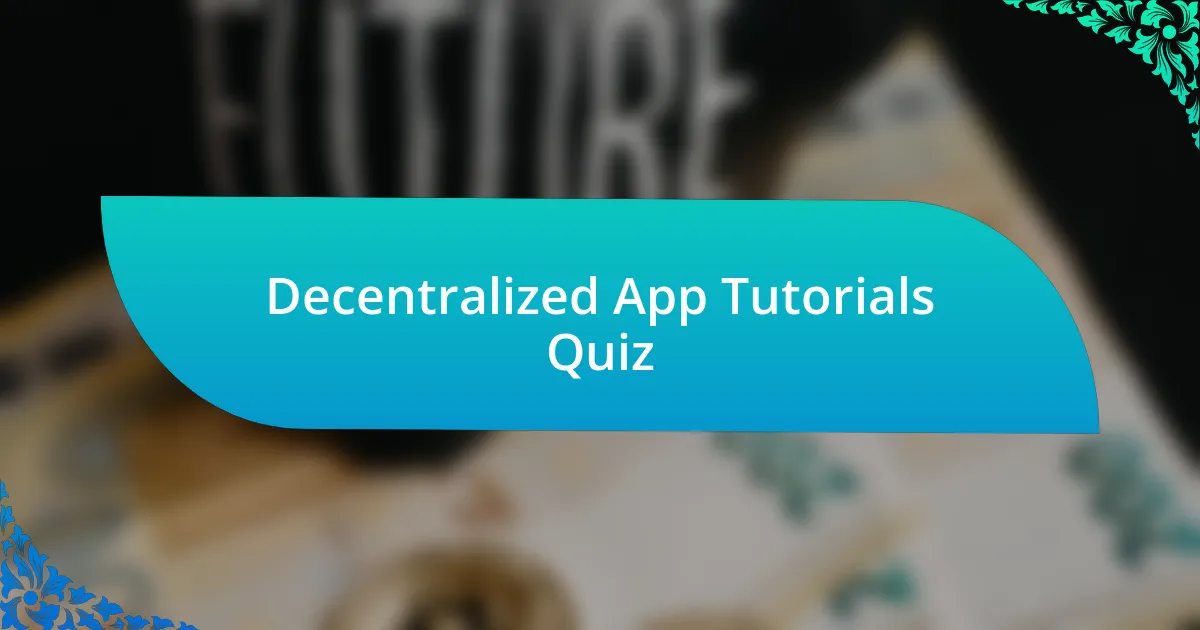
Start of Decentralized App Tutorials Quiz
1. What is the primary function of smart contracts in decentralized applications (dApps)?
- Provide cloud storage solutions
- Automate transactions without intermediaries
- Store user data securely
- Create a user interface design
2. Which platform is commonly utilized for developing dApps on the Ethereum blockchain?
- Solidity
- Python
- JavaScript
- C++
3. What programming language is widely used for writing smart contracts on Ethereum?
- Python
- Solidity
- Java
- Ruby
4. How do decentralized applications differ in data storage compared to traditional apps?
- Decentralized applications store data on a blockchain or peer-to-peer network.
- Decentralized applications only store data on local devices without a network.
- Traditional applications use a decentralized approach for data storage.
- Traditional applications do not utilize any form of data storage.
5. What is a DAO, and how does it relate to dApps?
- A DAO is a Decentralized Autonomous Organization that governs dApps through smart contracts.
- A DAO is a social media platform for dApps users.
- A DAO is a centralized company that runs dApps on private servers.
- A DAO is a type of hardware that improves dApps performance.
6. What is a common challenge developers face when creating user interfaces for dApps?
- Inability to connect with centralized services
- Excessive reliance on user accounts
- Limited access to coding resources
- Challenges in creating a user-friendly interface
7. What role does the Ethereum Virtual Machine (EVM) play in dApp development?
- The EVM designs user interfaces for dApps.
- The EVM tracks user activity in dApps.
- The EVM executes smart contracts for dApps.
- The EVM stores user data for dApps.
8. How do dApps achieve trustlessness in transactions?
- By requiring user confirmation for every single transaction to ensure accuracy.
- By using smart contracts that execute automatically on the blockchain.
- By encrypting all data and locking it on a personal device.
- By processing all transactions through a central server for efficiency.
9. What is the significance of gas fees in Ethereum dApps?
- Gas fees compensate miners for processing transactions on the Ethereum network.
- Gas fees are used to pay for server maintenance in centralized apps.
- Gas fees are collected for offering customer support services in dApps.
- Gas fees help users earn interest on their cryptocurrency holdings.
10. How can users interact with dApps on the Ethereum network?
- Users interact with dApps by sending emails to developers.
- Users interact with dApps only through dedicated mobile apps.
- Users interact with dApps via social media posts and comments.
- Users interact with dApps by using web browsers or specialized wallets.
11. What security measures can developers implement to protect dApps from vulnerabilities?
- Use unencrypted user passwords
- Disable user access to settings
- Store all data on a central server
- Implement smart contracts and auditing
12. What is the impact of network congestion on dApp performance?
- Decreased responsiveness and slower transaction times.
- Reduced data storage and lowered operating costs.
- Enhanced transaction speed and improved user experience.
- Increased security and more reliable connections.
13. How do oracles enhance the functionality of dApps?
- Oracles store cryptocurrency for dApps.
- Oracles control user identities in dApps.
- Oracles enhance graphics in dApps.
- Oracles provide real-world data to smart contracts in dApps.
14. What is tokenization, and how does it relate to dApps?
- Tokenization refers to the process of encrypting dApps to enhance security against hacking.
- Tokenization is the process of converting rights to an asset into a digital token on a blockchain, allowing dApps to facilitate ownership and transactions.
- Tokenization involves creating physical copies of digital assets for centralized apps only.
- Tokenization is about converting all cryptocurrencies into fiat currencies for easier trade.
15. In what ways do dApps ensure transparency for their users?
- Limited access and closed transactions
- Proprietary source code and private servers
- Open-source code and public blockchain
- Centralized control and hidden records
16. How can dApps contribute to financial inclusion?
- dApps restrict financial opportunities to those with high credit scores.
- dApps can provide decentralized access to financial services for unbanked populations.
- dApps can only be used by large corporations for internal transactions.
- dApps eliminate all forms of currency and cash transactions entirely.
17. What are Layer 2 solutions, and how do they improve dApp scalability?
- Layer 2 solutions eliminate the need for block validation in dApps, simplifying the process.
- Layer 2 solutions enhance dApp scalability by processing transactions off the main blockchain, reducing congestion.
- Layer 2 solutions make dApps slower by forcing all transactions on the main blockchain.
- Layer 2 solutions improve dApp scalability by increasing the transaction fees on the main chain.
18. What is the purpose of initial coin offerings (ICOs) in the context of dApps?
- To raise funds for developing dApps
- To create advertising revenue streams
- To buy cryptocurrencies in bulk
- To increase centralized app usage
19. How do decentralized exchanges operate within the dApp ecosystem?
- Decentralized exchanges only allow trading of a single cryptocurrency at a time.
- Decentralized exchanges facilitate peer-to-peer trading of cryptocurrencies without a centralized authority.
- Centralized exchanges automatically match orders of buyers and sellers without user input.
- Centralized exchanges require a single entity to control all transactions and data.
20. What are privacy-focused dApps, and what technologies do they leverage?
- Privacy-focused dApps use only encryption methods without leveraging blockchain technology.
- Privacy-focused dApps operate under a centralized authority to manage user privacy.
- Privacy-focused dApps rely solely on traditional databases to protect user information.
- Privacy-focused dApps utilize decentralized networks and blockchain protocols to secure user data.
21. How does user authentication differ in dApps compared to centralized applications?
- dApps use public-private key pairs for authentication.
- dApps solely rely on social media logins for user access.
- dApps require a username and password to access.
- dApps authenticate users through SMS verification codes.
22. What advantages do dApps have over traditional apps in terms of censorship resistance?
- dApps must comply with government regulations, limiting their censorship resistance.
- dApps operate on a decentralized network, making them difficult to censor.
- dApps rely on a central server for data storage, which increases censorship risk.
- dApps are hosted exclusively on private servers, allowing easy alteration by authorities.
23. What role do community votes play in governance for many dApps?
- Community votes determine app functionality and features.
- Community votes decide the marketing strategies of dApps.
- Community votes are used to set pricing for dApp services.
- Community votes enable decentralized governance in dApps.
24. What is the function of ERC standards in Ethereum dApp development?
- ERC standards manage internet bandwidth for dApps.
- ERC standards regulate user access to centralized servers.
- ERC standards dictate the layout of traditional apps.
- ERC standards define the interface for tokens on Ethereum.
25. How do dApps facilitate peer-to-peer lending and borrowing?
- dApps require a centralized bank to approve all loans.
- dApps only allow borrowing from large financial institutions.
- dApps facilitate lending by operating solely on USB drives.
- dApps use smart contracts to automate lending agreements directly between users.
26. What challenges do developers face when working with Ethereum`s gas limit?
- Limited user customization options
- Difficulty in accurately estimating transaction costs
- Excessive reliance on centralized servers
- Inability to create smart contracts
27. Why is open-source software important in the context of dApp development?
- It limits opportunities for user customization and feedback.
- It ensures software is only usable by a single entity.
- It increases costs of software production significantly.
- It fosters collaboration and innovation in development.
28. What are some examples of popular dApps built on the Ethereum blockchain?
- Uniswap
29. How can developers monetize their dApps effectively?
- Integrating ads and crypto donations
- Offering subscription-based services
- Selling physical merchandise
- Creating a centralized payment system
30. What ethical considerations should developers keep in mind when creating dApps?
- Selling user data
- Limiting internet access
- User consent and data privacy
- Increasing app size

Congratulations! You’ve Completed the Quiz!
It’s always exciting to finish a quiz, especially on a topic as dynamic as Decentralized App Tutorials. As you journeyed through the questions, you probably gained valuable insights into the basics of decentralized applications, their architecture, and the technologies that power them. These concepts are foundational for anyone looking to delve deeper into the world of blockchain and decentralized technologies.
Beyond the facts and figures, what you likely discovered is the significance of decentralization in today’s digital landscape. Understanding how decentralized apps strive for transparency, security, and user control can inspire you as you explore your own projects or interests in this field. Each question aimed to challenge your understanding and provoke thought about the future of technology and its applications.
If you found this quiz informative, we invite you to explore the next section on this page. Here, you can access a wealth of resources on Decentralized App Tutorials that will further enhance your knowledge. From practical guides to advanced concepts, there’s so much more to learn. Dive in and continue your journey into the fascinating world of decentralized applications!

Decentralized App Tutorials
Introduction to Decentralized Applications
Decentralized applications (dApps) operate on a peer-to-peer network, commonly utilizing blockchain technology. They differ from traditional applications by eliminating a central authority. This architecture enhances security, ensures transparency, and fosters user control over data. Ethereum is a well-known platform for building dApps, offering smart contracts to automate processes securely.
Key Components of Decentralized Apps
Decentralized apps comprise three primary components: the front-end, smart contracts, and the decentralized network. The front-end is the user interface that interacts with users. Smart contracts are self-executing contracts with predefined logic, running on a blockchain. The decentralized network consists of nodes that validate and store data, ensuring redundancy and reliability.
Step-by-Step Guide to Building a Simple dApp
To build a simple dApp, choose a blockchain platform like Ethereum. First, install development tools such as Node.js and Truffle. Next, create a smart contract using Solidity, the programming language for Ethereum. Deploy the contract on a test network using Truffle. Finally, develop the front-end using JavaScript frameworks like React, ensuring it communicates with the smart contract through web3.js.
Common Protocols and Standards in dApp Development
Several protocols and standards are essential in dApp development. ERC-20 defines a standard for fungible tokens on Ethereum. ERC-721 outlines non-fungible tokens (NFTs), allowing for unique asset representation. IPFS (InterPlanetary File System) enables decentralized file storage, complementing dApp functionalities. Utilizing these standards streamlines development and enhances interoperability.
Testing and Deploying Decentralized Applications
Testing dApps is crucial for ensuring functionality and security. Tools like Ganache allow developers to create a personal blockchain for testing smart contracts. After testing, deploy on the main net through platforms like Infura to connect to the Ethereum network. Monitor the dApp’s performance and security post-launch to maintain its reliability and trustworthiness.
What are decentralized app tutorials?
Decentralized app tutorials are instructional resources that guide users in creating, deploying, and utilizing decentralized applications (dApps). These tutorials cover various aspects such as smart contract development, blockchain integration, and user interface design. They often include step-by-step instructions, code snippets, and practical examples to facilitate learning. Statistics indicate that the demand for dApp development skills has surged, with platforms like Ethereum supporting a significant number of dApps.
How can I start learning decentralized app development?
To start learning decentralized app development, first choose a blockchain platform like Ethereum or Binance Smart Chain. Next, familiarize yourself with programming languages such as Solidity for smart contracts and JavaScript for front-end development. Utilize online resources, such as tutorials, e-books, and developer forums, to gain practical knowledge. A significant number of developers are becoming proficient in dApp development, with Ethereum alone hosting over 3,000 dApps as of 2023.
Where can I find decentralized app tutorials?
You can find decentralized app tutorials on various online platforms. Websites like Udemy, Coursera, and YouTube offer specialized courses. Developer communities, such as GitHub and Stack Overflow, also share valuable tutorials and resources. As of 2023, numerous educational websites dedicated to blockchain and dApp development provide structured materials targeted at different skill levels.
When should I start learning about decentralized apps?
You should start learning about decentralized apps as soon as you have a foundational understanding of programming and blockchain technology. The growing interest in decentralized finance (DeFi) and non-fungible tokens (NFTs) has created a robust market for dApps, making now an opportune time to acquire these skills. Current trends indicate that the dApp ecosystem is expanding rapidly, with an increasing number of projects emerging in various sectors.
Who can benefit from decentralized app tutorials?
Individuals such as software developers, blockchain enthusiasts, and entrepreneurs can benefit from decentralized app tutorials. These tutorials equip them with essential skills for building and understanding dApps. Moreover, businesses looking to integrate blockchain solutions into their operations also gain valuable insights from these resources. Market research shows that the global blockchain market size is projected to reach $67.4 billion by 2026, indicating a strong demand for skilled professionals in this field.

